
Hannah Borden Palmer (October 8, 1843 - January 26, 1940) was a temperance reformer.

Hannah Borden Palmer (October 8, 1843 - January 26, 1940) was a temperance reformer.

Hannah Chambers Borden was born in Battle Creek, Michigan, on October 8, 1843. Her father was a Presbyterian clergyman, Edmund Woodmansee Borden (1822-1893). On her mother's side, Margaret Hopper (1823-1901), she descended from Andries Willemszen Hoppe (1622-1658), who was among the first settlers of Manhattan Island. She was the oldest of a family of eight children, the four surviving siblings were: Almira C. Rice (1845-1934), Emma L. Borden (1848-1872), Edmund James Borden (1852-1927), Flora E. Exelby (1864-1941). [1]
Edmund Woodmansee Borden was the second son of Tyler and Hannah Borden and was born in Monmouth county, New Jersey, on March 30, 1822. When twenty years old he married Margaret Hopper of New York City and with her moved to Michigan in 1843, at the time a pioneers land. He died on February 27, 1893, after fifty-three years of ministry. He is buried with his wife at Forest Hill Cemetery (Ann Arbor, Michigan). [2]
At the age of sixteen Palmer entered Albion College, in Albion, Michigan, and after a three-year course of study took her master's degree, M. A. 1862. [1] [3]
After graduation Hannah Borden Palmer began to teach in the union school in Lapeer, Michigan. [1]
In 1864 Palmer accompanied her husband to the front with his regiment, camping with them until the muster-out in September 1865. After that home duties and the care of her children occupied her time until the crusade began. [1]
She was elected president of the Woman's Christian Temperance Union, of Dexter, Michigan, under whose guidance and auspices were organized a public library and reading-room. [1]
She opened a private school in Colorado, which she conducted with success until she moved to Buffalo, New York. [1]
Mainly through her efforts, a lodge of Good Templars was organized in Boulder, Colorado, and she was its presiding officer for five successive terms. [1]
Her love for children induced her to organize a Band of Hope, which soon grew to nearly two-hundred members. During that time she became a member of the Woman's Christian Temperance Union of Boulder and soon received the gavel. [1]
In the spring of 1886 business led her husband to Buffalo, in the practice of his profession. Seeing in the Royal Templars what she believed to be a fruitful source of great good, she united with that order, serving as chaplain, vice-councilor and select councilor. After three years as select councilor of Advance Council No. 25 she declined reelection. Her council sent her as its representative to the Grand Council in February 1890. On her first introduction into that body she was made chairman of the committee on temperance work and was elected grand vice-councilor, being the first woman to hold that position in the jurisdiction of New York. In the subsequent sessions of the Grand Council in February 1891, and February 1892, she was reelected grand vice-councilor, being the only person ever reelected to that office. [1]
In November 1864, Hannah Borden married Dr. Elmore Palmer (December 16, 1839 - October 23, 1909), son of Layton Palmer, then surgeon of the 29th Michigan Volunteer Infantry Regiment. [1] [3] [4] Dr. Palmer wrote a lengthy series in 1908 and 1909 about Albion History in the Albion Mirror newspaper entitled "Biographical Sketches", which provided valuable information about the early history of Albion. Palmer attended the Albion public school, and the Albion Seminary and Albion College. He graduated from the University of Michigan at Ann Arbor as a medic in 1864. His uncle, Dr. Alonzo B. Palmer was dean of the medical school there. [5]
In 1881, after the death of all four of her children, she moved to Boulder, Colorado, and then in 1886 to Buffalo, New York, always with her husband. They lived at 309 Plymouth Avenue. [1] She spent the last 5 years of her life at the Episcopal Church Home and died from arterial sclerosis on January 26, 1940. She was buried as a pauper at the Forest Lawn Cemetery (Buffalo) with no headstone together with her husband's ashes. [3]

The International Organisation of Good Templars, whose international body is known as Movendi International, is a fraternal organization which is part of the temperance movement, promoting abstinence from alcohol and other drugs.

Martha McClellan Brown was an American lecturer, educator, reformer, newspaper editor, and major leader in the temperance movement in Ohio.

Henry Franklin Thomas was an American physician and politician from the U.S. state of Michigan. He served two terms in the United States House of Representatives from 1893 to 1897
Hannah Connell Barker (1844–1918) was an early resident of Boulder, Colorado. Barker was a teacher, civic leader, businesswoman and land developer in an era when industrious women were not commonly recognized for their contributions. Among other things, Barker served as a teacher; as director of the Boulder Bank; and was instrumental in platting and developing significant parts of the City of Boulder. She also owned the land that was used for the construction of Barker Meadow Reservoir, Boulder's primary source of water.

Margaret Bright Lucas was a British temperance activist and suffragist. She served as president of the British Women's Temperance Association (BWTA), the World's Woman's Christian Temperance Union (WCTU), and the Bloomsbury branch of the Women's Liberal Association.
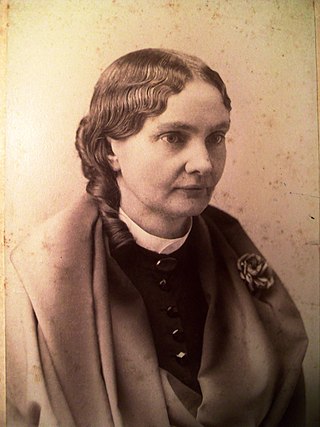
Mary Jewett Telford a nurse at Hospital No. 8 in Nashville, Tennessee, during the American Civil War. In her later years, Telford was a published writer, editor of numerous journals, lecturer on the temperance circuit and charter member of the Woman's Relief Corps, an auxiliary to the Grand Army of the Republic.
Icie Gertrude Macy Hoobler was an American biochemist who did research in human nutrition, specifically pertaining to mothers and children. Despite facing discrimination because of her gender, she became the first woman chair of a local section of the American Chemical Society and won 22 awards and honors for her laboratory's research.
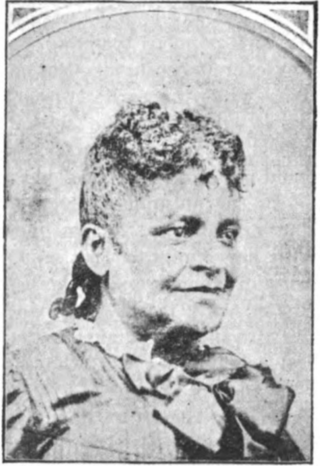
Naomi Bowman Talbert Anderson was an African American suffragist, temperance leader, civil rights activist, and writer who advocated for equal rights for all genders and races in the 1870s. She wrote poetry and gave speeches highlighting the experience of African American women who were still enslaved by their inability to vote, receiving considerable praise from other suffragists for her contributions to the movement.
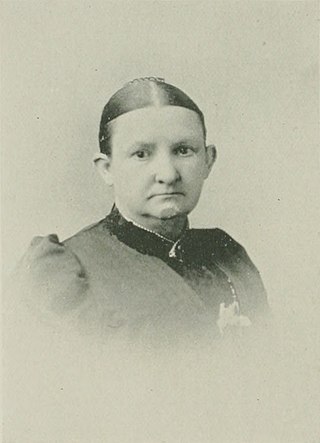
Hannah Johnston Bailey was an American Quaker teacher, activist, and advocate for peace, temperance, and women's suffrage.

Caroline Elizabeth Merrick was an American writer and temperance worker. She is the author of Old Times in Dixie Land: a Southern Matron's Memories (1901). Taking an active part in the charitable and philanthropic movements of New Orleans, she served as president of the Ladies' Sanitary and Benevolent Association, of the Woman's Foreign Missionary Society of the Methodist Episcopal Church, and of the Woman's League of Louisiana.

Delia Lionia Stearns Weatherby was an American temperance reformer and author.

Mary Bigelow Ingham was an American author, educator, and religious worker. Dedicated to teaching, missionary work, and temperance reform, she served as professor of French and belles-lettres in the Ohio Wesleyan College; presided over and addressed the first public meeting ever held in Cleveland conducted exclusively by religious women; co-founded the Western Reserve School of Design ; and was a charter member of the order of the Daughters of the American Revolution.

Mary Lathrap, pen name: Lena; known as "The Daniel Webster of Prohibition", was a 19th-century American author, preacher, suffragist, and temperance reformer. For 20 years, she was identified with the progressive women of Michigan who had temperance, purity, and prohibition as their watchwords, and the white ribbon as their badge. A licensed preacher for the Methodist Episcopal Church (1871), she served as president of Michigan's Woman's Christian Temperance Union (1882), co-founded the state's suffrage organization (1870), and worked on the amendment campaign (1874). She died in 1895, aged 56.
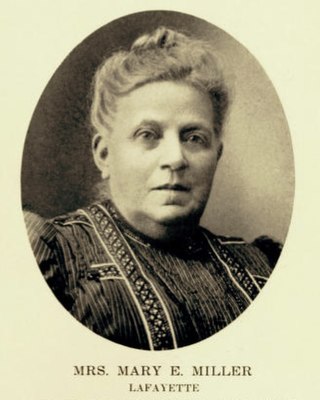
Mary E. Miller (1843–1921) settled in the Territory of Colorado in 1863 with her husband, Lafayette Miller. After her husband died, she founded the town of Lafayette, Colorado, named for her husband. Miller was called the "Mother of Lafayette. She was the first woman bank president in the United States, a philanthropist and an astute businesswoman.
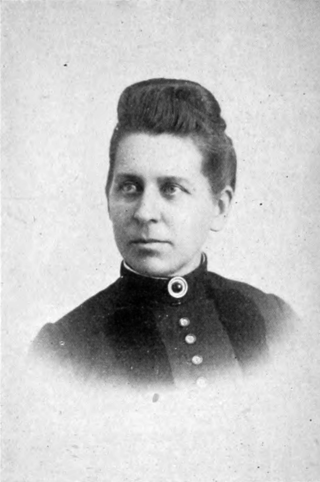
Cornelia Moore Chillson Moots was an American missionary and temperance evangelist. She was one of four pioneer missionaries of the Woman's Foreign Missionary Society of the Methodist Episcopal Church.
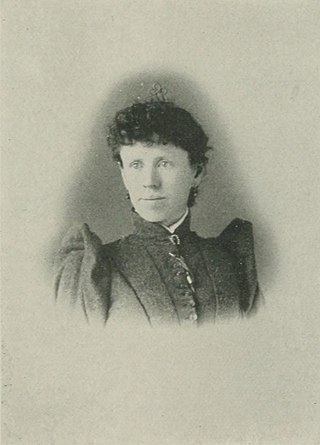
Eva C. Doughty was an American journalist, newspaper editor, and suffragist. She was the co-founder of the Michigan Woman's Press Association and the Mt. Pleasant Library, Literary and Musical Association. She served as president of the Grand Rapids Equal Suffrage Association.

Margaret Ray Wickens was an American public affairs organizer, social reformer, and charitable organization leader who served as tenth National President of the Woman's Relief Corps (WRC). Eloquent, Wickins was called the "Golden-tongued orator of the Woman's Relief Corps". Her executive abilities during the years that she was actively engaged in WRC advanced the organization's patriotic work. As an orator, philanthropist and industrial worker, Wickens had no peer. She served as president of the Kansas State Assembly of Rebekahs, and was active in the temperance movement, filling the role of district president of her Woman's Christian Temperance Union (WCTU) for several years. She was a teacher, a member of the Daughters of the American Revolution (DAR), and a prominent Good Templar. In her later life, she held a number of state positions in Illinois.

Jessie Forsyth was a British-American temperance advocate. She joined the International Organisation of Good Templars (IOGT) in London in 1872, relocated to New England for decades, and celebrated her Jubilee while residing in Western Australia. During her 50 years membership, Forsyth filled many important offices, including 15 years as International Superintendent of Juvenile Templars, in the course of which she visited jurisdictions in Great Britain, the United States and Canada and many parts of continental Europe. She edited the International Good Templar Magazine for eight years and, at different times, did the editorial work on seven other temperance publications, in addition to being a contributor of short stories and poems to newspapers and magazines. She made addresses in various countries before large audiences, including one in the Royal Opera House, Stockholm, and did much secretarial work. The last years of her life were chiefly devoted to work for the WCTU until she was compelled to resign active service on account of ill health.

Ellen Sergeant Rude was an American author, poet, and temperance advocate. While involved in the temperance movement, she was affiliated with the International Organisation of Good Templars (I.O.G.T.) and the Woman's Christian Temperance Union (W.C.T.U.).
{{cite book}}: CS1 maint: multiple names: authors list (link) CS1 maint: numeric names: authors list (link)